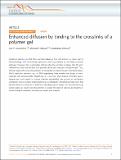| dc.contributor.author | Goodrich, Carl P. | |
| dc.contributor.author | Brenner, Michael P | |
| dc.contributor.author | Ribbeck, Katharina | |
| dc.date.accessioned | 2019-03-25T17:05:38Z | |
| dc.date.available | 2019-03-25T17:05:38Z | |
| dc.date.issued | 2018-10 | |
| dc.identifier.issn | 2041-1723 | |
| dc.identifier.uri | http://hdl.handle.net/1721.1/121079 | |
| dc.description.abstract | Creating a selective gel that filters particles based on their interactions is a major goal of nanotechnology, with far-reaching implications from drug delivery to controlling assembly pathways. However, this is particularly difficult when the particles are larger than the gel’s characteristic mesh size because such particles cannot passively pass through the gel. Thus, filtering requires the interacting particles to transiently reorganize the gel’s internal structure. While significant advances, e.g., in DNA engineering, have enabled the design of nano-materials with programmable interactions, it is not clear what physical principles such a designer gel could exploit to achieve selective permeability. We present an equilibrium mechanism where crosslink binding dynamics are affected by interacting particles such that particle diffusion is enhanced. In addition to revealing specific design rules for manufacturing selective gels, our results have the potential to explain the origin of selective permeability in certain biological materials, including the nuclear pore complex. | en_US |
| dc.description.sponsorship | National Science Foundation (U.S.) (through Harvard Materials Research Science and Engineering Center Grant DMR-1420570) | en_US |
| dc.description.sponsorship | National Science Foundation (U.S.). Designing Materials to Revolutionize and engineer our Future (Grant DMR-123869) | en_US |
| dc.description.sponsorship | United States. Office of Naval Research (Grant N00014-17-1-3029) | en_US |
| dc.description.sponsorship | National Institutes of Health (U.S.). National Institute for Biomedical Imaging and Bioengineering (Grant R01 EB017755-04) | en_US |
| dc.description.sponsorship | National Science Foundation (U.S.). Career Award (PHY-1454673) | en_US |
| dc.description.sponsorship | National Science Foundation (U.S.). Materials Research Science and Engineering Centers (Program) (DMR-1419807) | en_US |
| dc.publisher | Nature Publishing Group | en_US |
| dc.relation.isversionof | http://dx.doi.org/10.1038/s41467-018-06851-5 | en_US |
| dc.rights | Creative Commons Attribution 4.0 International license | en_US |
| dc.rights.uri | https://creativecommons.org/licenses/by/4.0/ | en_US |
| dc.source | Nature | en_US |
| dc.title | Enhanced diffusion by binding to the crosslinks of a polymer gel | en_US |
| dc.type | Article | en_US |
| dc.identifier.citation | Goodrich, Carl P., Michael P. Brenner, and Katharina Ribbeck. “Enhanced Diffusion by Binding to the Crosslinks of a Polymer Gel.” Nature Communications 9, no. 1 (October 19, 2018). | en_US |
| dc.contributor.department | Massachusetts Institute of Technology. Department of Biological Engineering | en_US |
| dc.contributor.department | Massachusetts Institute of Technology. Department of Mathematics | en_US |
| dc.contributor.mitauthor | Brenner, Michael P | |
| dc.contributor.mitauthor | Ribbeck, Katharina | |
| dc.relation.journal | Nature Communications | en_US |
| dc.eprint.version | Final published version | en_US |
| dc.type.uri | http://purl.org/eprint/type/JournalArticle | en_US |
| eprint.status | http://purl.org/eprint/status/PeerReviewed | en_US |
| dc.date.updated | 2019-03-04T13:38:14Z | |
| dspace.orderedauthors | Goodrich, Carl P.; Brenner, Michael P.; Ribbeck, Katharina | en_US |
| dspace.embargo.terms | N | en_US |
| dc.identifier.orcid | https://orcid.org/0000-0001-8260-338X | |
| mit.license | PUBLISHER_CC | en_US |
